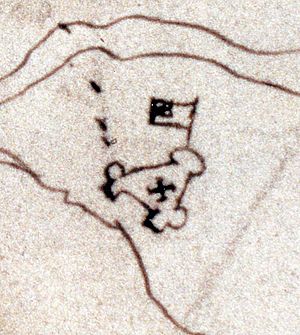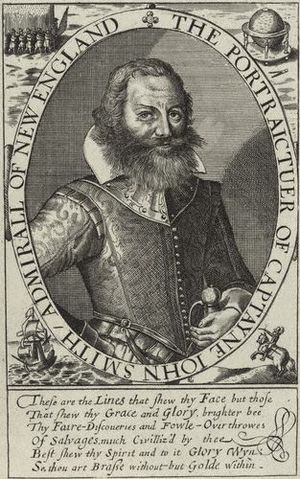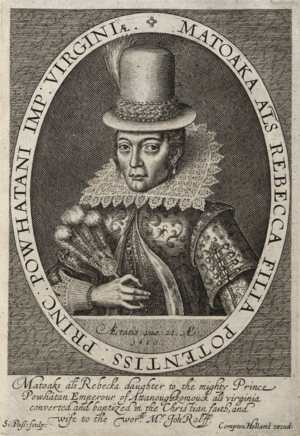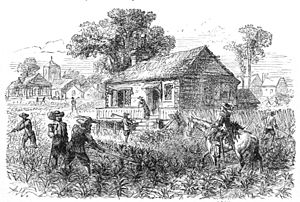History of Jamestown, Virginia (1607–1699) facts for kids
Jamestown was the first English settlement in the Virginia Colony. It was started in 1607. Jamestown was the capital of Virginia until 1699. Then, the government moved to Williamsburg. This article tells the story of the fort and town of Jamestown. It also covers important events in the colony while Jamestown was its capital.
Contents
The First Journey and Landing
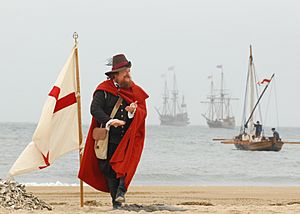
In December 1606, the London Company sent a group to start a settlement. They sailed on three ships: the Susan Constant, the Godspeed, and the Discovery. There were 105 men and boys, plus 39 crew members. They left from Blackwall, England.
After a long journey, they reached the Chesapeake Bay in April 1607. One person died on the way. On April 26, they landed at Cape Henry. They set up a cross and held a special ceremony. This spot is known as the "first landing."
Finding a Place to Settle
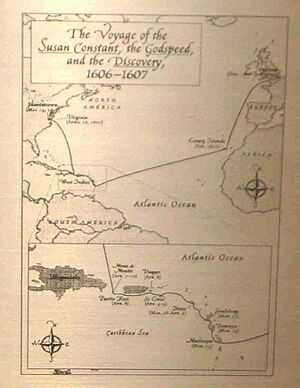
When they arrived, the settlers opened secret orders from the Virginia Company. These orders said that Captain John Smith should be on the governing council. Smith had been arrested during the trip. But he was set free when the orders were opened. The orders also told them to find a settlement site inland. This would protect them from enemy ships.
The ships sailed further into Chesapeake Bay. They landed again at Old Point Comfort in Hampton. Then, they went up the James River. Both the river and the new settlement were named after King James I. The settlement was first called "James His Towne."
Choosing Jamestown Island
On May 14, the colonists picked Jamestown Island for their settlement. The Virginia Company wanted a place that was easy to defend. Other European countries like the Dutch Republic, France, and Spain were also starting colonies. They were often at war with England.
Jamestown Island was a good choice. It had clear views up and down the James River. It was also far enough inland to avoid enemy ships. The water next to the land was deep enough for their ships. This allowed them to anchor close by and leave quickly if needed. Also, Virginia Indians did not live on the island. Most of them were part of the Powhatan Confederacy.
The First Leaders
King James I had chosen the members of the first council. This group would govern the new settlement.
The first council members included:
- Bartholomew Gosnold
- Christopher Newport
- John Smith
- Edward Maria Wingfield (the first president)
Starting the Settlement
Building the Fort
The settlers quickly began building their first fort. Many of the first settlers were not ready for life in Jamestown. Some were upper-class gentlemen not used to hard work. There were very few farmers or skilled workers. Robert Hunt, a chaplain, held the first Christian prayer at Cape Henry. He continued to hold services at Jamestown.
Even though the island was empty, Paspahegh Indians attacked the settlers soon after they arrived. One settler was killed, and eleven were hurt. Within a month, the triangular James Fort was built. It had wooden walls, a storehouse, a church, and houses. A week later, Captain Newport sailed back to London. He left 104 colonists and the Discovery ship behind.
The settlers soon learned why the Virginia Indians did not live there. Jamestown Island was a swampy area. It was hard to hunt because there was little game. The settlers quickly hunted all the animals on the small peninsula. Also, the low, marshy area had many mosquitoes. These mosquitoes carried malaria. The river water was salty and dirty. This caused many deaths from salt poisoning, fevers, and dysentery. The colonists struggled to grow food. They became dependent on supplies from England.
New Arrivals
Newport returned from England twice with more supplies. These were called the first and second supply missions. The "first supply" arrived in January 1608. It brought more than 70 new colonists. But it did not have enough food. Soon after, the fort burned down.
The "second supply" arrived in October 1608. It brought 70 more settlers. Among them were the first two women known to come to Jamestown. These were Mistress Forrest and her maid, Anne Burras.
This supply also brought the first non-English settlers. These were skilled craftsmen. They came from places like Germany and Poland. They were hired to make things for export. Some built a glass furnace, which was the first factory in British North America. Other craftsmen made soap and wood supplies. These were the first products made in America and sent to Europe. But these exports did not make enough money for the investors in England. No gold or silver was found either.
Ongoing Challenges
John Smith's Leadership
Before becoming president of the colony in September 1608, John Smith explored the Chesapeake Bay. He often traded for food with the Nansemond Indians and other groups. In December 1607, Smith was captured by the Powhatan. He was taken to Chief Powhatan at Werowocomoco. Later, Smith claimed that Powhatan's young daughter, Pocahontas, saved his life. Many historians question if this story is true.
In September 1609, Smith was hurt in an accident. His powder bag exploded. He was sent back to England for medical care. While in England, Smith wrote books about his time in Jamestown. These books helped create more interest and investment in the colony.
Company Expectations
The investors in the Virginia Company expected to make a lot of money. They sent a letter to Jamestown leaders with their demands. John Smith, who was now president, wrote a strong reply. He told them to send skilled workers like carpenters, farmers, and blacksmiths. He said these were more useful than a thousand people who needed to be fed and housed. The investors in London seemed to understand. Their third supply mission was the largest and best equipped. They even built a new ship, the Sea Venture.
Pocahontas's Role
Pocahontas, Chief Powhatan's daughter, had little contact with John Smith. But she became a link between the Native Americans and the colonists. After a fire destroyed the fort in January 1608, Pocahontas brought food and clothes to the settlers. She also helped negotiate for the release of Native Americans captured by the colonists.
Over time, relations between the Native Americans and colonists became tense. Especially during the "Starving Time" in late 1609. Chief Powhatan moved his capital further inland.
In April 1613, Pocahontas was captured by Englishmen. She was taken to the English settlement at Henricus. There, she became a Christian and took the name "Rebecca." She married a planter named John Rolfe. This marriage greatly improved relations between the Native Americans and the colonists for several years. Pocahontas and Rolfe had a son, Thomas Rolfe. They went to England to help raise money for the Virginia Company. Sadly, Pocahontas became sick and died in England. She was buried at St George's Church.
The Starving Time
The "Starving Time" happened in the winter of 1609–10. Out of 500 English colonists, only 60 survived. The colonists had planned to trade with local Native Americans for food. They also relied on supply ships from England. But a drought in 1609 meant fewer crops.
Then, problems arose with their other food sources. The third supply mission from England was delayed. After Smith left for England, Chief Powhatan stopped trading food with the colonists. John Ratcliffe, Smith's replacement, was killed by the Powhatans while trying to get food. No supply ships arrived as winter began.
The Sea Venture Shipwreck
In 1609, Vice-Admiral Christopher Newport led a fleet of nine ships from England. The flagship, Sea Venture, carried important people like Thomas Gates. A strong storm, possibly a hurricane, hit the fleet. The Sea Venture was separated from the other ships. To prevent it from sinking, the ship was steered onto the reefs of Bermuda. All 150 passengers and crew were safe, but the ship was badly damaged.
The survivors spent nine months on Bermuda. They built two smaller ships, Deliverance and Patience. They used wood from Bermuda cedar trees and parts from the Sea Venture.
The survivors finally reached Jamestown on May 23, 1610. They found the colony in ruins. Fewer than 100 settlers were left, and many were sick. The Bermuda survivors had brought few supplies. So, they decided to leave Jamestown and return to England. On June 7, they boarded their ships and sailed down the James River.
Lord De La Warr Arrives
Just as the settlers were leaving Jamestown, a new governor arrived. This was Thomas West, Baron De La Warr. He arrived on June 9, 1610, with more colonists and supplies. He met the departing settlers about 10 miles downstream from Jamestown. He ordered them to return. The Deliverance and Patience turned back. All the settlers landed at Jamestown again. De La Warr brought a doctor, food, and much-needed supplies. He became a strong leader for Virginia.
Growing Beyond Jamestown
By 1611, most of the first colonists had died. The colony was not making much money. Only promises of more land from King James I kept the project going.
First Anglo-Powhatan War
The Anglo-Powhatan Wars were conflicts between English settlers and the Powhatan Confederacy. The First War began in 1610 and ended with a peace agreement in 1614.
Tobacco Becomes Important
John Rolfe was one of the settlers who arrived after the Sea Venture shipwreck. He was the first to successfully grow export tobacco in the colony. The native tobacco was not popular in Europe. But Rolfe brought seeds of a different kind of tobacco. He started exporting it in 1612. Soon, other colonists followed. Growing tobacco became very profitable, like a gold rush.
Governor Dale and His Laws
In 1611, Thomas Dale arrived in Jamestown. He was sent by the Virginia Company to help govern the colony. He found the conditions unhealthy. He immediately started rebuilding Jamestown.
Dale served as governor for a few months in 1611 and then from 1614 to 1616. During his time, the first strict laws of Virginia were used. These laws, called "Dale's Code," were very harsh.
Henricus Settlement
Dale looked for a better place than Jamestown. He sailed up the James River to what is now Chesterfield County. In 1611, he began building a new settlement called Henricus. This was meant to be a possible new capital. However, it was later destroyed during the Indian massacre of 1622.
Indian Attack of 1622
Relations with the Native Americans worsened after Pocahontas died. Diseases, poor harvests, and the need for more tobacco land caused problems. After Chief Powhatan died in 1618, his brother Opechancanough became chief. He wanted to remove the English settlers from Native American lands. This led to another war from 1622 to 1632.
On March 22, 1622, Opechancanough led surprise attacks on English settlements. Almost 347 colonists were killed. Many communities were destroyed.
However, Jamestown was saved. A Native American boy named Chanco warned colonist Richard Pace. Pace quickly warned Jamestown. The town narrowly escaped destruction.
Virginia Becomes a Royal Colony
In 1624, the Virginia Company lost its charter. Virginia became a crown colony, directly controlled by the King. In 1634, the English Crown created eight areas called shires. James City Shire included Jamestown. Later, it was renamed James City County.
New Town and Palisade
The original Jamestown fort likely existed until the mid-1620s. As Jamestown grew eastward into a "New Town," the old fort was no longer mentioned. By 1634, a wooden fence (palisade) was built across the Virginia Peninsula. This fence was about 6 miles wide. It provided some safety from Native American attacks for colonists living further down the peninsula.
Third Anglo-Powhatan War
On April 18, 1644, Opechancanough tried again to force the colonists out. He led more attacks, killing almost 500 colonists. But this was a smaller portion of the growing population than in 1622. In 1646, Royal Governor William Berkeley captured Opechancanough. Opechancanough was very old, perhaps 90 to 100 years old. While a prisoner, he was killed by a soldier.
In 1646, the first treaties were signed between the Native Americans and the English. These treaties created reservations for the surviving Powhatan people. They also set up yearly payments from the Native Americans to the English. The war created a boundary between the two lands. People could only cross it with a special pass.
Bacon's Rebellion
Bacon's Rebellion was an uprising in 1676. Virginia settlers, led by Nathaniel Bacon, rebelled against Governor William Berkeley. Berkeley had been governor before. He and Bacon disagreed about relations with the Native Americans.
In 1675, Doeg Indians raided a plantation. This led to more raids and conflicts. Berkeley tried to calm things down. But many colonists, especially those on the frontier, did not listen. Bacon ignored orders and attacked Native Americans who were friendly to the colonists.
Bacon gained support against the governor. He led raids on friendly Native American tribes. Berkeley offered him forgiveness. Bacon was even elected to the House of Burgesses. He was captured, forced to apologize, and then pardoned by Berkeley.
Bacon then demanded to lead the military. Berkeley refused. Bacon and his supporters surrounded the statehouse. They threatened to shoot if Berkeley did not agree. Berkeley eventually gave in and then left Jamestown. Bacon's forces later captured and burned Jamestown to the ground on September 19, 1676. Bacon died of sickness soon after.
Berkeley returned and executed the main leaders of the rebellion. Because Jamestown was burned, the government met at Berkeley's plantation and later at Middle Plantation. King Charles II was unhappy with Berkeley's actions. He called Berkeley back to England.
The Capital Moves from Jamestown
Jamestown had always been Virginia's capital. It had a statehouse and a church. Ships could easily reach it. But Jamestown's importance was declining. In 1662, it was no longer the only required port for Virginia.
On October 20, 1698, the statehouse in Jamestown burned down for the fourth time. The legislature met at Middle Plantation. This time, they met at the College Building of the College of William & Mary. While there, students from the college suggested moving the capital permanently.
The students argued that Middle Plantation was on higher ground. This would avoid the malaria and mosquitoes that plagued swampy Jamestown. They also pointed out that Middle Plantation had access to two rivers through deep creeks. Many important people had already built homes there.
The idea to move the capital was accepted. In 1699, the capital of the Virginia Colony officially moved to Middle Plantation. The town was renamed Williamsburg, in honor of King William III.
Later History
By the 1750s, the land was owned and farmed by families like the Travis and Ambler families. During the American Revolutionary War, a military post was on the island. American and British prisoners were exchanged there. During the American Civil War, Confederate soldiers built a fort near the church. This was part of their defense to block Union ships going up the river to Richmond. More recently, efforts have been made to preserve Jamestown's history.
|


